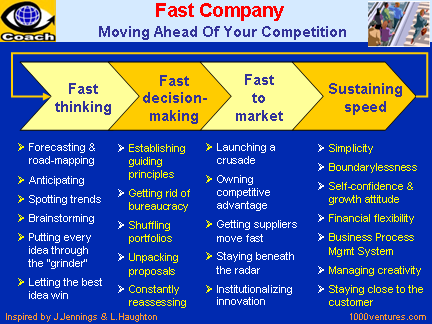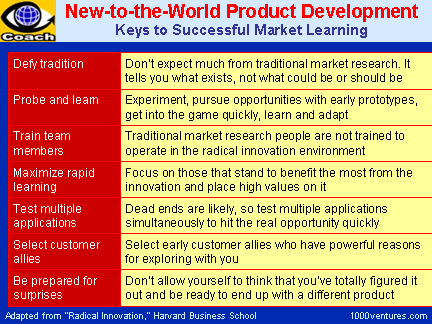|
Contents
1. New Product Development Strategies
10 Best Practices of the Most
Successful Companies
Best
Practices: Dynamic Strategy Formulation by Silicon
Valley Companies
The Need for Strategy Innovation
New Product Types
Managing Your Project Portfolio
Radical
vs. Incremental Innovation
Lifestyle vs.
Venture
Management
5 Critical Success Factors for New
Ventures
Venture
Strategies: Internal and External Ventures
Success
Story:
Corning –
In-Company Ventures
Best
Practices:
Venture Acquisitions by Apple
New Product Blueprint
Creating a New Product Blueprint: 6
Components
2. Inventing and Designing a New Product
Five Levels To a Product
Why New
Products Fail?
New Product Development (NPD): 7 Stages
and 4 Sub-Processes
Engaging
Cross-functional Teams
Best Practices:
Cross-functional Innovation Teams at Quantum
New Product Development by
Cross-functional Teams
Lessons
from Dell: Turn Your Customers Into Teachers
Customer-driven Innovation: 7 Practice Tips
Challenging Assumptions
Inventing
New Products: 6 Inventive Thinking Techniques
Inventing
New Products: Selected TRIZ Principles
SCAMPER Idea Generation Technique
Perfect
Brainstorming: 10 Rules
Techniques for Fast Evaluation of Ideas
and Decision Making
Idea Evaluation by Weighted Criteria
Innovation Football Simulation Game:
Evaluating the Idea and the Team
New
Product Design: 5 Stages and Refining Process
7 Reasons
for Shifting to New Approaches
Best
Practices:
New Product Design: 5-Step Methodology by
IDEO
Best
Practices:
Apple's Design Process
Lessons
from IDEO:
Keeping Eyes Open for Inspiration
New
Product Design:
Observing
People
Radical
Innovation: A Different Role of
Prototyping
Alpha-Testing and Beta-Testing of a New
Product
Success
Story:
Procter & Gamble Align Probiotics
Beta-Testing: Market Learning and
Discovering Customer Values
New-To-The-World Product Development: Keys To
Market Learning
DOs and
DON'Ts of a Successful Innovator
3.
Corporate
Innovation System
Corporate
Innovation System: 5+1 Element
Inspiring
Culture
Creating a
Culture for Innovation: 5 Strategies
An Ideal New Product Environment
The Tao of Intellectual
Cross-pollination
Facilitating Cross-pollination of Ideas
Managing
Innovation Projects: Business Synergies Approach
Milestone-based Thinking
Best
Practices:
Indiaco's
Milestone Program
Measuring
Innovation: Benefits, Role, and Practices
New Product Metrics
Best
Practices:
Innovation
Metrics Used by Silicon Valley Firms
4.
Innovation
Process
Best
Practices:
Attributes
of Effective Innovation in Silicon Valley
Managing
Operations vs. Managing Innovation
Radical
Innovation: Key Uncertainties
Radically
New Product Development: Key Uncertainties
Specific Skills of
Radical
Project Managers
Fuzzy
Front End
Loose-Tight Leadership
Innovation Process: The Traditional
Phase-Gate Model
Innovation Process: Traditional vs.
Modern Flexible Model
Project Management: Business
Administrations vs. Business Synergies
The Jazz
of Innovation
The Jazz of Innovation: Key Components
Creative
Chaos Environment
Experimentation – The Key To Discovery
The Jazz
of Innovation: 11 Practice Tips
5.
Entrepreneurial Organization and People
Entrepreneurial Organization: 10 Characteristics
and 5 Benefits
Best Practices:
Organizational Structure of
Silicon Valley Firms
Inspiring People: 4 Key Strategies
Create a
Culture of Questioning
New Product Director
Entrepreneurial Leaders: 4 Specific
Attributes
Creative Leadership DOs and DON'Ts
Motivate Innovators
Best Practices:
Rewarding Innovative
Behavior in Silicon Valley Firms
6.
Business Model and Marketing Strategies
Business
Model: 6+1 Components
Success
Story:
Dell Inc. – New Business Model
Success
Story:
Amazon.com – Creating Competitive Advantage
Strategic Alliances
Mutual Creativity in Business
Partnerships
Customer
Value Proposition
Success
Story:
Xerox – Innovative Revenue Model
Market Development Trend
Lessons from
Steve Jobs:
Sell Dreams and Emotional Benefits
Brand Building and New Product
Marketing
Barriers To Market Entry
Differentiation Strategy: 3 Parts and 4 Steps
Weak and Strong Differentiation
Strategies
Success
Story:
Half.com – Creative Buzz Marketing
Yin-Yang of
Value
Innovation
7.
Fast To Market
First To
Market: Importance and Tactics
Fast Company: 4 Components
Success
Story: Charles Schwab – Fast Company
Best
Practices: Charles Schwab – Establishing Guiding
Principles
Launching
a Crusade
Owning
Your Competitive Advantage
Lessons
from Jack Welch:
Simplify
Lessons
from Silicon valley Firms:
Creating a Relentless Growth Attitude |
Sample Ten3 SMART Lessons
(Slide
+ Executive Summary)

Product: a
Broad Definition
According to Phillip Kotler, a
product is anything that can be offered to a market for
attention, acquisition, use, or consumption that might
satisfy a need or want. Thus, a product may be a physical
good, retail store, person, organization, place, or idea.
Product /
Service Innovation Defined
Product/service innovation is
the result of bringing to life a new way to solve the
customer's problem – through a new product or service
development – that benefits both the customer and the
sponsoring company.
Defining the
Scope and Time Frame of Product Innovation Required
According to Peter Drucker, the
following four questions must be answered to define how much
innovation is required, in what areas and in what time
frame:
How much longer will this product still grow?
How much longer will it maintain itself in the marketplace?
How soon can it be expected to age and decline – and how
fast?
When will it become obsolescent?
Product
Roadmap
Product roadmaps define new
product and service initiatives within a market of
technology context. They embody a large percentage of the
corporate strategy and provide a degree of tangibility that
helps bring together other choices in direction, technology,
marketing and so forth to the surface. Furthermore, starting
with product roadmaps forces people to be explicit about how
their ideas translate into new products or services. It is
vital for developing product roadmaps to discover
assumptions beneath the selection of products.
New Product
Development: Critical Milestones
Searching for opportunities,
both internally and externally (spotting trends, observing
people) – Brainstorming – Initial design – Prototyping –
Test marketing – Final design – Manufacturing

Achieving
and Maintaining Speed – the Key to Success
In the new economy where
everything is moving faster and it's only going to get
faster, the new mantra is, Do it more with less and do
it faster. In order to get real speed decisions at
virtually every level must be made in minutes, not days
or weeks. Decisions also have to be made face-to-face,
not memo-to-memo. This means that people have to think
on their feet, and that the forests of meaningless paper
trails and approvals – so common in large organizations
– must be eliminated.
Entrepreneurial Mindset
Venture values are
different from established corporate shared values.
Entrepreneurial independence demands space for action
and trust, while independence in a corporation implies
responsibility and control imposed from above.
Entrepreneurial speed demands agility, experimentation,
adaptation, and rapid response in order to be first to
market. Corporate experimentation comprises analysis,
review, sober consideration of facts, and willingness
sacrifice speed for thoroughness.
Moving
with Speed: The Four Components
Fast thinking:
anticipating the future, spotting trends before others,
challenging assumptions, and creating a corporate
environment where the best idea – regardless of origin –
wins.
Fast decision-making:
establishing corporate guiding principles, blowing off
stifling bureaucratic structures, shuffling portfolios,
constantly reassessing everything, and matching the
decision to the consequence.
Fast to market:
removing in-built speed-breakers, abandoning traditional
visions and missions and launching a crusade instead,
owning and exploiting your competitive advantage,
getting vendors and suppliers operating on your
timetable, staying beneath the radar, and building
virtuous circles of speed.
Sustaining speed:
maintaining velocity through working on your business,
injecting the relentless growth attitude into the firm,
being ruthless with resources, building a scoreboard
that measures activity, staying financially flexible,
proving the math, institutionalizing innovation, and
staying close to the customer.

|